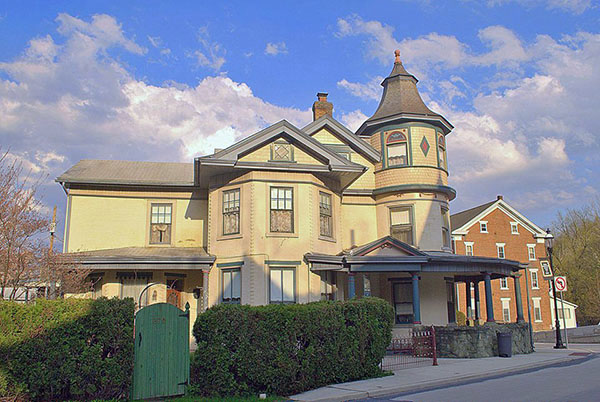This house on the northeast corner of Main and Diamond Streets, 370 Main Street, was the home of Henry Kuntz (1830-1905), one of the wealthiest men in Slatington in the late nineteenth century. The house, built circa 1856-58, was also known as “breezy villa” or “breeze villa.” It is also an early example of the Queen Anne architectural style.
Henry Kuntz was born on 10 October 1830, the son of Jacob Kuntz (1797-1847) and Rachel Butz (1800-1884). The family lived in what was then Heidelberg township but is now Washington township. Jacob Kuntz was a miller near Slatington.
Henry Kuntz was a
- grandson of Johann Jacob Kuntz (1759-1841) and Christiana Mosser 1764-1836)
- great-grandson of Bernhard Kuntz (1723-1807) and Anna Eberhard (1723-1780); Bernhard married a second time, Anna Oplinger (1724-1804).
- great-great-grandson of John Jacob Kuntz from Alsace (1692-1754) and Anna Pfalzgraf (1695-1738). John Jacob married a second time in 1742, Susanna Klein (1711-?). John Jacob Kuntz arrived in Philadelphia in 1738 and settled in what is now an area of Berks County.
Henry Kuntz started his career as a farm laborer and then became a clerk, and later manager, of a store. He then started his own store at Odenwelder (now part of West Easton) in Northampton County. In 1850 he moved to Slatington, where he ran a hotel for two years and then opened a slate quarry. Initially, he was in a partnership with Benjamin Kern (1834-1918), his brother-in-law. When the partnership dissolved, Kuntz continued to try his hand with other slate quarries. In 1876 Henry Kuntz bought the dry good store of Elias German in lower Slatington, and then three years later he bought the McDowell store on the corner of Main and Dowell streets in Upper Slatington. He continued to operate dry goods stores in Slatington for the rest of his life.
In 1880 Kuntz leased the Big Franklin quarry, which was located on the north side of Trout Creek at Emerald, and he operated it for a period of ten years. When others thought the quarry was exhausted, he again leased and worked it until his death. During his life, he controlled many quarries through the Slatington Slate Co, incorporated in 1895.
Thus, Kuntz’s wealth was built on his ownership of dry goods stores, his extensive real estate holdings and rental properties and his slate operations, which centered on the working of the massive Big Franklin quarry.
Kuntz also served for twenty-six years as justice of the peace, and he was elected town burgess in 1892.
The Kuntz house is located on the northeast corner of Diamond and Main Streets in Slatington. This location was the site of the original log home of Nicholas Kern, built about 1741. In 1807, when John Kern (1777-1851), the grandson of Nicholas, rebuilt the old log home, he also built a stone barn. In 1894 the western portion of the barn was removed to allow for the opening of Diamond Street. The remaining portion of that barn is the oldest surviving structure in Slatington.
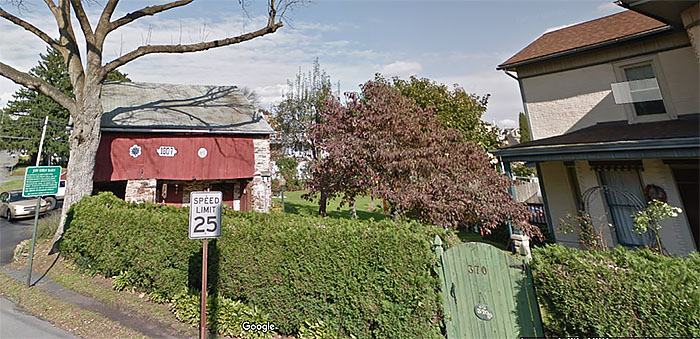
The 1807 Kern barn, photo credit: Google street view
The 1807 log house was torn down in 1858 by Kuntz in order to build his house. The house also served as the office for his slate operations.
After the death of Henry Kuntz, his widow moved to Allentown, and S. B. Costenbader, Kuntz’s son-in-law, owned the house. At some point-in-time, the house passed to Wesley W. Bowman (1849-1941), another one of Kuntz’s sons-in-law. Much later, it was a dentist office.
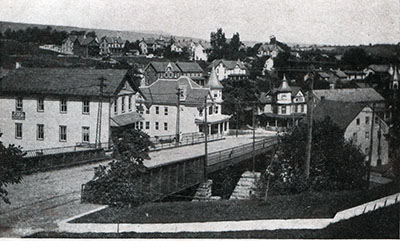
Circa 1910 view of the Main Street bridge with the Kuntz house in the center at the bottom of the bridge
In 1849, Kuntz married Violetta Kern who died 20 July 1863 at the young age of 31 leaving six daughters (Amanda, Zenia, Damietta, Catherine, Caroline, Martha). Through this marriage, Kuntz came into possession of much property in lower Slatington, including the Kern grist mill, which he leased out.
In 1865 Kuntz married Elizabeth Boyer, who died in 1895. There were two more daughters added to the family (Irene and Lillie).
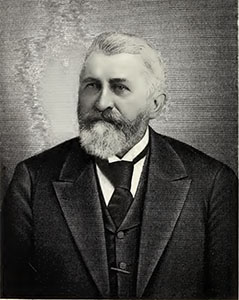
Henry Kuntz
All told, there were three wives and eight daughters.
Henry Kuntz married his first wife in 1849, Violetta Elizabeth “Eliza” Kern (1832-1863), daughter of Jonas Kern (1805-1892). Jonas was the great-grandson of the first Kern settler in the area, Nicholas Kern. These were the daughters:
- Amanda Isabella (1849-1938) in 1869 married Henry Augustus Kline (1844-1906). They lived in Allentown.
- Zenia Francesca (1851-1938) in 1870 married Wesley Weis Bowman (1849-1941). They lived in Slatington, and Wesley managed quarry operations.
- Damietta L. (1853-1896) “Dana” in 1873 married Dr. William H. Kuntz (1845-1907). They lived in New Castle, Delaware.
- Katherine A. (1855-1935) “Kate” in 1876 married Walter Bayard Grosh (1851-1909). They lived in St. Louis, St. Augustine, FL, and Slatington.
- Caroline Violetta (1857-1933) “Carrie” about 1885 married Thomas H. Drake (1854-1897) of Slatington, and then in 1900 she married Rev. Charles M. Sandt (1866-1940). They lived in Philadelphia and Slatington.
- Martha Josephine (1860-1940) “Mattie” in 1883 married Rev. George Washington Sandt (1954-1931). They lived in Philadelphia and Allentown. (George was a cousin of Charles Sandt.)
Henry Kuntz married his second wife in 1865, Elizabeth Boyer (1838-1895). They had two daughters.
- Irene A. (1866-1948) in 1890 married Francis G. Ritter (1857-1921). They lived in Allentown.
- Lillie May (1869-1944) in 1892 married Silas Benjamin Costenbader (1869-1941). They lived in Slatington.
Henry Kuntz married his third wife in 1896. She was Anna Eliza Arner née Schaeffer (1845-1915).
At his death in 1903, Henry Kuntz was extremely wealthy. His estate included insurance policies, bank stock, stock in the Slatington Slate Co., and other stock and bond holdings. Some of the many properties named in his will and estate documents included:
- a brick storehouse on Main and Dowell Street
- a brick house on Dowell Street
- six tenant houses on Fourth Street
- two double houses on North Street
- a double house on Rextown Road
- two double houses on the south side of Franklin Street
- tracts of land on Hill Street, Maple Street and Church Street
- his homestead, including “all the ground east of Second Street and along Main to Railroad and north to an alley back of north street.”
The executors of the will were three of Kuntz's sons-in-law (Francis Ritter, Wesley Bowman, and George Sandt).
I've driven past the Kuntz house literally thousands of times, and probably walked past it hundreds of times more, and I've always admired the great, old house. It must have been truly spectacular in the nineteenth century before automobiles and before Diamond Street was even created.
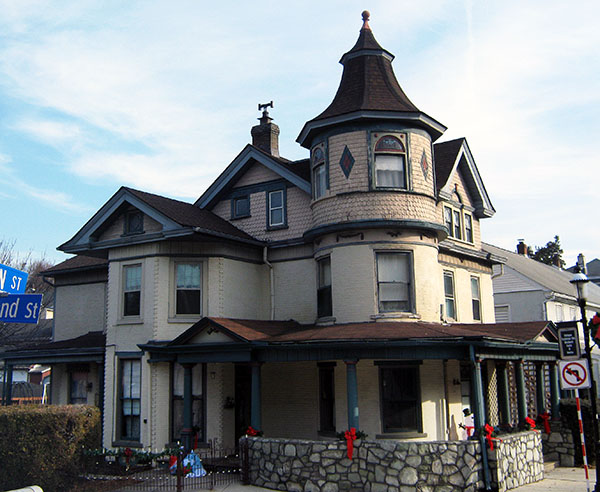
Current view of the Kuntz house, 2023
